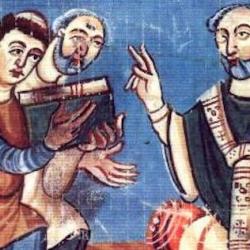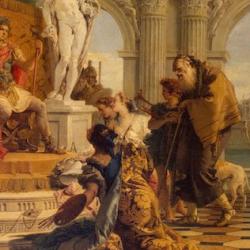Massimo Montanari claims in his Medieval Tastes that medieval tastes and customs regarding food were changed by two revolutions.
One involves the discovery of new foods from the new world. Think, for instance, of “the impact of the tomato on Mediterranean cooking or the potato on the continental diet, not to mention corn, which assumed first place in the diet of the peasantry, or plants like the chili pepper, which were adopted with such conviction in certain regions of Europe (in particular, Hungary and, within Italy, calabria) as to become in time the distinctive characteristic of the local gastronomic identity. . . . Wheat, wine, oil, pork, and beef—basics of the european dietary model—appeared for the first time in the americas, as did sugar and coffee, which the europeans transplanted along with squadrons of african slaves sent to cultivate them.”
The other revolution came later, and was a shift in the understanding of the aims of cookery. Medievals believed that cooking and seasoning were unavoidably artificial; but that yielded to the view that cooking should be designed to bring out the natural flavors of the foods. This shift in cooking “ideology” was also a shift in dietary philosophy. As Montanari writes,
“A retrospective examination that goes from today back to the Middle ages immediately reveals that our notion of cooking, the system of flavors that seem to us ‘naturally’ desirable, is significantly different from the one that for ages—not only during the Middle ages, but even a few centuries ago as well—people considered good and looked for in foods. Contemporary cooking (in Italy and other european countries) has a primarily analytic character that tends to separate sweet, salty, bitter, sour, and spicy, reserving for each one an autonomous place, both in individual foods and in the order of the meal. This kind of practice is allied with the idea that cooking must respect, insofar as possible, the natural flavor of each food, different and particular from one time to the next, and for that reason keep each one separate from others. But these simple rules do not constitute a universal archetype of cooking that always existed and was always the same. They are the result of a minor revolution that took place in France during the seventeenth and eighteenth centuries. . . . Renaissance cooking, medieval cooking, and, going back even further, ancient Roman cooking had evolved a model based principally on the idea of artificiality and the mingling of flavors. The preparation of a single foodstuff, as well as its position within the meal, corresponded to a synthetic rather than an analytic logic: to keep together rather than separate.”
This was not merely a philosophy of cooking. Medieval cooking was “a cuisine of contrast that is in search of balance, the ground zero where distances between flavors are abridged.” Cooking aimed for that balance of contrasts not only for culinary reasons, but for moral and ethical reasons: Diet was embedded in a notion of the soul as well as of the body.











